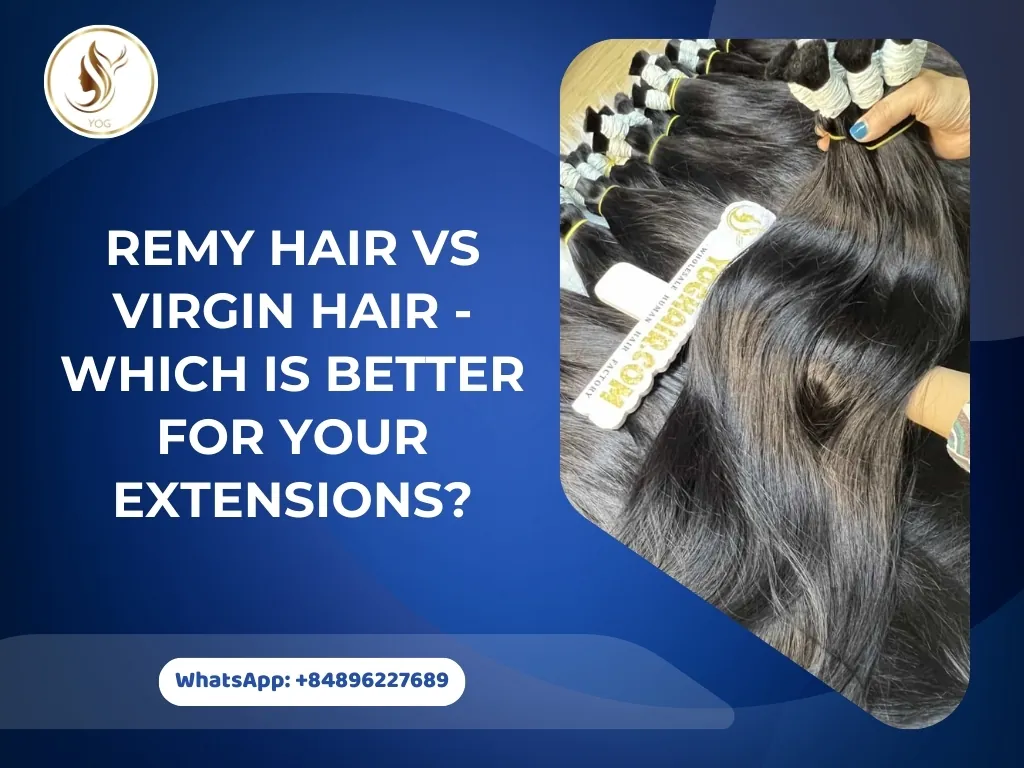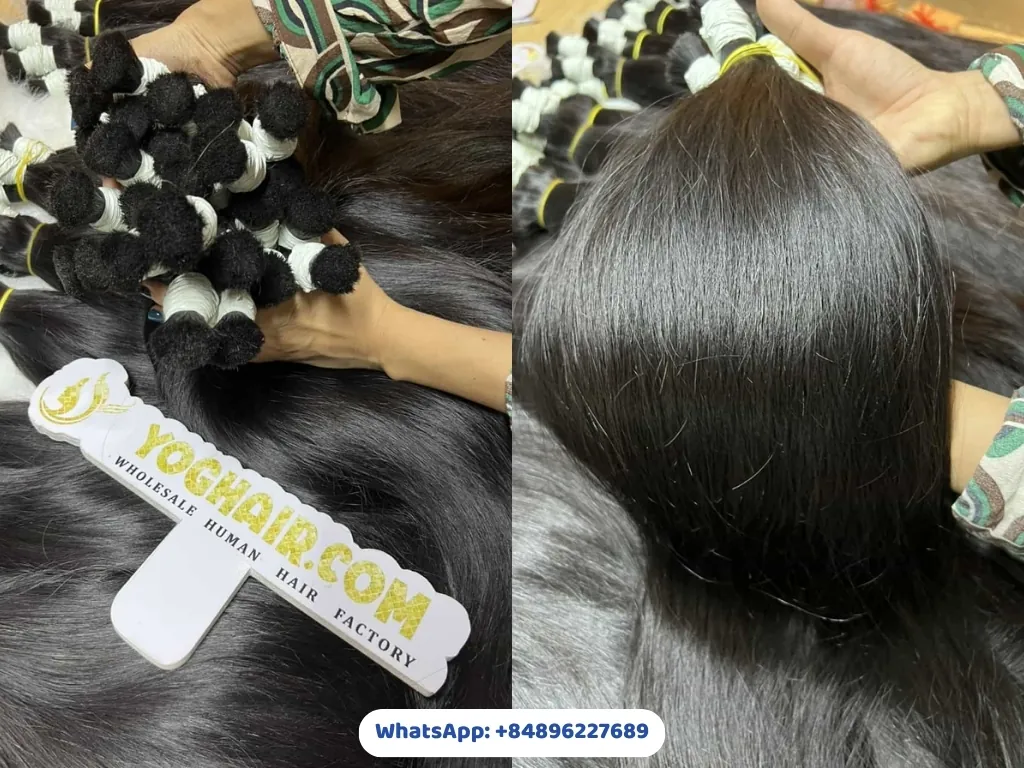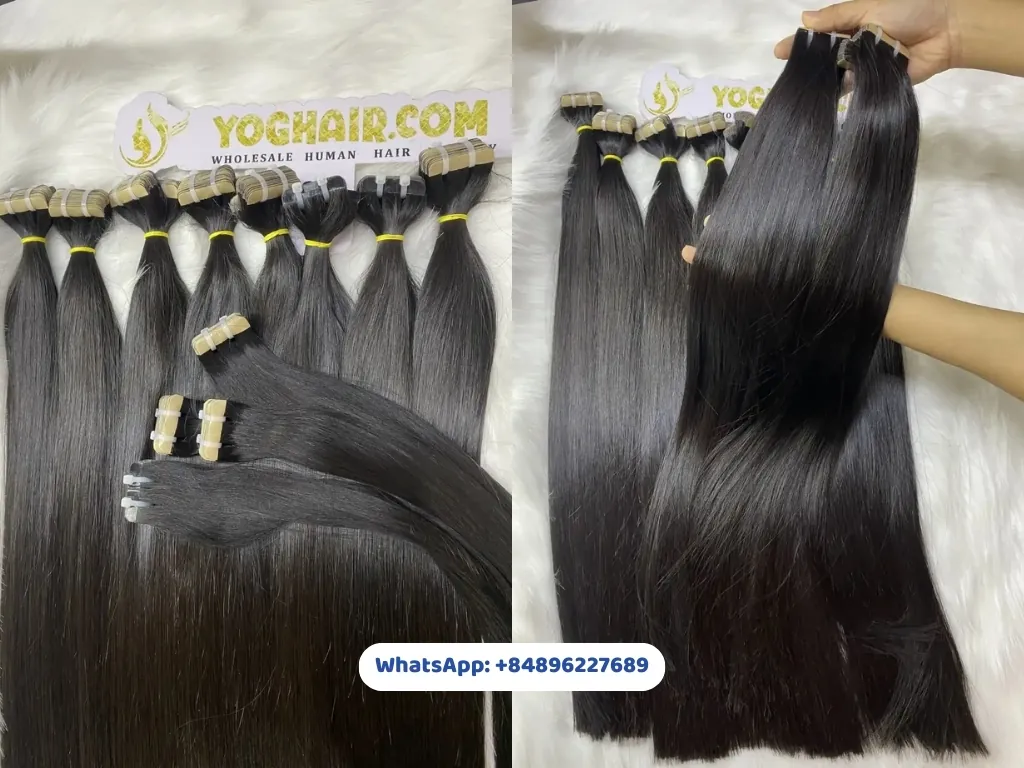When shopping for high-quality hair extensions, you’ve likely come across the terms virgin hair and Remy hair—but what’s the real difference? Understanding the key distinctions between virgin hair vs Remy hair can help you make an informed choice that aligns with your styling goals, budget, and maintenance expectations. In this guide, YogHair will break down everything you need to know about these two popular hair types, from how they’re sourced to how they perform over time.

What is virgin hair?
Some people also ask: What is virgin Remy hair? It’s important to clarify that not all Remy hair is virgin. In the realm of hair extensions, “virgin hair” refers to 100% human hair that has never been chemically processed in any way. This means it has not been dyed, bleached, permed, straightened, or treated with any harsh chemicals. It’s hair that is cut directly from a donor’s head and remains in its original, unaltered state. The key difference between virgin hair and raw hair is that its cuticles are intact and aligned in the same direction, just as they grew naturally from the scalp. This intact cuticle layer is crucial for preventing tangling and matting, contributing to the hair’s overall quality and longevity.

Pros of Virgin hair
Virgin hair is highly sought after for several compelling reasons:
- Purity and natural state: It’s the purest form of human hair available, completely free from chemical damage. This means it retains its natural strength, luster, and softness.
- Intact cuticles, minimal tangling: The cuticles are all aligned in the same direction, mimicking natural hair growth. This significantly reduces tangling, matting, and shedding, making the hair easier to manage and style.
- Exceptional durability and longevity: Because it hasn’t been weakened by chemical treatments, virgin hair is remarkably strong and can last for a long time – often a year or more with proper care. This makes it a cost-effective investment in the long run, despite the higher initial virgin hair vs Remy hair cost.
- Versatility in styling: Virgin hair can be dyed, bleached, permed, and styled just like your own natural hair. Its unprocessed nature allows it to hold color and styles exceptionally well, offering limitless customization options. You can achieve vibrant colors and intricate styles without compromising the hair’s integrity.
- Natural look and feel: Due to its untouched state, virgin hair blends seamlessly with natural hair, providing an incredibly natural and undetectable look. It moves and feels like your own hair, giving you a truly authentic result
Cons of Virgin hair
While virgin hair offers numerous advantages, there are a few drawbacks to consider:
- Higher cost: This is arguably the most significant con. The meticulous sourcing and lack of processing contribute to a considerably higher price point compared to Remy hair or other types of human hair. This is a direct reflection of its superior quality and longevity.
- Limited color and texture options (Initially): Since it’s unprocessed, virgin hair comes in its natural color (typically shades of black or brown) and texture (straight, wavy, or curly). If you desire a specific color or a highly processed texture (like a deep wave that doesn’t naturally occur), you will need to process it yourself or have a professional do it.
- Requires expertise for customization: While versatile, dyeing or bleaching virgin hair still requires skill to achieve desired results without damaging the integrity. It’s always recommended to seek professional assistance for chemical alterations to preserve the hair’s quality.
- Potential for slight texture variation: As virgin hair comes from individual donors, there might be slight variations in texture or natural color between bundles, even if they are from the same “type” (e.g., straight). This is a testament to its authenticity, but it’s something to be aware of when purchasing multiple bundles.
What is Remy hair?
Remy hair refers to 100% human hair that has its cuticles intact and, most importantly, aligned in the same direction from root to tip. This critical feature is what sets it apart from non-Remy human hair.
When hair is collected, if the cuticles are not preserved and aligned, the hair strands will rub against each other in opposing directions, leading to severe tangling, matting, and a dull appearance. Remy hair is typically collected directly from a donor’s head, ensuring that the hair remains “root first” and “tip last” throughout the collection process.
While virgin hair is always Remy, not all Remy hair is virgin hair. This is a crucial distinction. Remy hair can be, and often is, chemically processed, meaning it may have been dyed, permed, straightened, or otherwise treated to achieve specific colors, textures, or styles.
The key is that this processing is done after the hair is collected and its cuticle alignment is preserved. This controlled processing is what allows for a wider variety of readily available colors and textures in Remy hair compared to the naturally limited options of virgin hair.

Pros of Remy hair
Remy hair is a popular choice for hair extensions due to its many advantages:
- Reduced tangling and matting: The aligned cuticles are the primary benefit of Remy hair. This significantly minimizes tangling and matting, making the extensions much easier to comb, brush, and maintain, even after washing. This makes a huge difference in the daily wearability and longevity of the extensions. Remy human hair extensions are favored for offering salon-quality results with minimal tangling.
- Natural appearance and movement: Because the cuticles are intact and flowing in the same direction, Remy hair has a natural luster and sheen. It moves and blends seamlessly with your own hair, providing a realistic and undetectable look. It doesn’t have the dull, “straw-like” appearance often associated with non-Remy hair where the cuticles have been stripped or misaligned.
- Good durability and lifespan: While not as long-lasting as virgin hair, Remy hair still offers good durability. With proper care, Remy hair extensions can last anywhere from 6 to 12 months, depending on the quality of the hair and how well it’s maintained. This makes it a cost-effective option for many.
- Wider range of available colors and textures: Remy hair is often pre-colored and pre-textured (e.g., body wave, deep wave, kinky curly) through gentle processing. This offers consumers a broader selection of ready-to-wear styles and colors, making it easier to find an exact match for their desired look without needing further chemical treatments.
Cons of Remy hair
Despite its advantages, Remy hair does have some potential drawbacks:
- Can be processed (Not always pure): The biggest con is that Remy hair can be chemically processed (dyed, permed, straightened). These processes can still slightly alter the hair’s integrity and reduce its lifespan compared to truly virgin hair. You need to be aware of the level of processing when purchasing.
- Shorter lifespan than virgin hair: Due to potential chemical treatments and often being from multiple donors, Remy hair typically doesn’t last as long as virgin hair.
- Potential for mixed hair if not sourced properly: A significant concern in the market is mislabeled or low-quality “Remy” hair and some people confuse ‘’Is Remy hair synthetic?’’ Some suppliers might mix true Remy hair with non-Remy hair or even synthetic fibers, leading to tangling and disappointment. This is why reliable sourcing is crucial.
- Requires consistent care: While less prone to tangling than non-Remy hair, Remy hair still requires consistent and proper care to maintain its quality and prolong its life.

Key differences between Remy hair and Virgin hair
Understanding the difference between Remy and Virgin hair helps buyers make the right investment. Virgin hair and Remy hair are both high-quality options for hair extensions, but they differ significantly in their processing, sourcing, and characteristics. Below, Yoghair outlines the key difference between human hair and virgin hair to help you make an informed choice.
Processing level
Virgin hair is completely unprocessed, meaning it has never been chemically treated, dyed, bleached, permed, or altered in any way. It retains its natural state, including its original color, texture, and cuticle alignment, making it the purest form of human hair available for extensions.
Remy hair is also 100% human hair but may undergo minimal processing, such as cleaning, conditioning, or slight color treatment (e.g., to standardize color across bundles). The defining feature of Remy hair is that its cuticles are kept intact and aligned in the same direction (root to tip), which prevents tangling and maintains a natural look. However, it is not guaranteed to be completely unprocessed like virgin hair.
Sourcing and donor origin
Virgin hair typically sourced from a single donor to ensure consistency in texture, color, and quality. This single-donor sourcing contributes to its premium quality and uniformity, as all strands come from one person’s hair.
Remy hair is often collected from multiple donors, which can lead to slight variations in texture or quality within a bundle. The hair is carefully sorted to ensure cuticle alignment, but it may not have the same level of uniformity as virgin hair. Where does Remy hair come from? Remy hair is commonly sourced from regions like India, China, Brazil, or Malaysia, often through hair donations at temples (e.g., in India), salons, or direct donor programs where individuals sell their hair.
Cuticle integrity
The cuticles of Virgin hair are always intact and aligned, as the hair is unprocessed and sourced from a single donor. This alignment reduces tangling, enhances shine, and ensures a natural flow, mimicking how hair grows from the scalp.
The cuticles of Remy hair are also intact and aligned, which is why Remy hair is considered high-quality. However, because it may come from multiple donors and undergo minimal processing, there’s a slightly higher chance of minor inconsistencies compared to virgin hair.
Cost
Virgin hair is significantly more expensive due to its unprocessed nature and single-donor sourcing. A 100-gram bundle of virgin hair (e.g., 20 inches) typically costs $50–$200, depending on length, origin, and texture. Remy hair, being more widely available and potentially lightly processed, is more affordable, with prices ranging from $30–$100 per bundle for similar lengths. The higher cost of virgin hair reflects its premium quality and exclusivity, while Remy hair offers a cost-effective alternative for those seeking high-quality human hair.
Versatility and styling
Because it’s unprocessed, virgin hair is highly versatile for styling. It can be dyed, bleached, curled, or straightened with minimal risk of damage, as it starts in a pristine state. However, it’s only available in natural colors (usually black or dark brown) and textures (straight, wavy, curly) specific to the donor.
Remy hair is also versatile but may have limitations if it has been lightly processed (e.g., pre-dyed or treated). Repeated chemical treatments on Remy hair can cause more damage compared to virgin hair, as it may not be as resilient due to prior processing.
Durability and longevity
With proper care, virgin hair can last 1–2 years or longer because its intact cuticles and unprocessed nature make it highly durable. It’s ideal for long-term use in extensions or wigs.
Remy hair is also durable, typically lasting 6 months to a year with good care. However, its longevity may be slightly shorter than virgin hair if it has undergone any processing, as this can weaken the hair over time.

Remy hair vs Virgin hair: Which is suitable for you?
If you’re deciding between raw virgin hair vs Remy hair, this section outlines the practical differences. The choice between Remy hair vs Virgin hair depends on your budget, styling needs, and how long you want your extensions to last. Virgin hair is the best choice for those seeking the highest quality, unprocessed hair with superior durability and styling versatility, ideal for long-term use or professional styling, but it comes at a higher cost ($50–$200 per bundle). Remy hair is a cost-effective alternative ($30–$100 per bundle) that still offers high-quality human hair with aligned cuticles, suitable for shorter-term use or those new to extensions.
Conclusion
Yoghair answers some questions about where does Remy hair come from, or Virgin hair vs Remy hair cost difference. In the end, understanding Remy hair vs Virgin hair comes down to knowing your styling needs, budget, and long-term hair goals. Virgin hair offers unmatched purity and longevity, while Remy hair provides excellent quality with more accessibility. Both are great choices for extensions but the best option depends on what matters most to you.
Whether you’re after all-natural strands or a balance between quality and cost, now you’re equipped to choose the perfect hair for your next look. Ready to experience the difference? Buy 100% Vietnamese Human Hair at Yoghair and discover the quality that’s right for you!
- Instagram: @yoghair_wholesale_factory
- WhatsApp: +84896227689
- Email: [email protected]








 Ms. Jenifer
Ms. Jenifer
